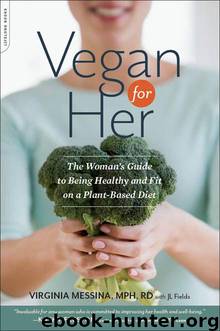Vegan for Her by Virginia Messina

Author:Virginia Messina
Language: eng
Format: mobi, epub
ISBN: 9780738216720
Publisher: Da Capo Press
Published: 0101-01-01T00:00:00+00:00
NUTRIENTS FOR STRONG BONES
The more we study bone health, the more it becomes clear that maintaining healthy bones throughout life depends on the interaction of numerous dietary and lifestyle factors. In addition to calcium and protein, healthy bones need adequate vitamin D, vitamin K, magnesium, potassium, and even vitamin C. There are a few challenges here for vegans, but mostly advantages.
Calcium: Many women, whether or not they drink milk, fall short of meeting calcium recommendations. In vegans, there is evidence that calcium shortfalls take a toll on bone health. In the EPIC-Oxford study, vegans were more likely to suffer broken bones than nonvegans, but it was only because they had low calcium intakes. Vegans with higher calcium intakes were at no greater risk.13 The best sources of calcium for vegans are collard and turnip greens, kale, bok choy, calcium-set tofu, fortified plant milks and juices, figs, tahini, and blackstrap molasses. As you’ll see below, the other nutrients in calcium-rich plant foods make them especially good choices for protecting bone health.
Vitamin D: There is evidence that vitamin D might protect against a wide range of chronic illnesses, including fibromyalgia, cancer, hypertension, and rheumatoid arthritis. But its most important function is in boosting calcium absorption in the intestines and reducing its excretion from the kidneys in order to provide adequate calcium for bones. While osteoporosis results from loss of bone content, a vitamin D deficiency can lead to osteomalacia, which is a defect in bone building.
If our early human ancestors had depended on food for vitamin D, our species would have been in trouble, because there are very few natural sources of this nutrient. A few high-fat fish provide it and so do eggs from chickens who are fed a vitamin D-rich diet. As a result, throughout all of human history, most people were not getting vitamin D from their diet. The main source of vitamin D has always been what we synthesize ourselves when skin is exposed to sunlight. When humans started to move farther from the equator and also began to spend more time indoors, they had more trouble making enough vitamin D. As a result, it was added to cow’s milk, which became an important source of this nutrient for many people. Today, many foods, including plant milks, are fortified with vitamin D.
Exposing arms and legs to the sun three times a week for 10 to 30 minutes during midday on a day when sunburn is possible, and without using sunscreen, should produce enough vitamin D in light-skinned young women. The darker your skin and the older you are, the more exposure you need. And it’s important to weigh this exposure against skin cancer risk. For this reason, a daily dose of 600 to 1,000 IUs of vitamin D can be a good idea for most women. Most supplements of vitamin D come from animals, but vegan vitamin D—called vitamin D2 or ergocalciferol—is available.
Protein: After decades of criticism for its alleged bone-damaging effects, protein is back on the list of bone-protective nutrients.
Download
This site does not store any files on its server. We only index and link to content provided by other sites. Please contact the content providers to delete copyright contents if any and email us, we'll remove relevant links or contents immediately.
| Non-Vegan Vegetarian | Vegan |
Dinner in an Instant by Melissa Clark(3055)
Ottolenghi - The Cookbook by Yotam Ottolenghi(2808)
Oh She Glows Every Day by Angela Liddon(2684)
Veg by Jamie Oliver(2383)
Superfood Smoothie Bowls: Delicious, Satisfying, Protein-Packed Blends that Boost Energy and Burn Fat by Chace Daniella(2355)
The Starter Garden Handbook by Alice Mary Alvrez(2257)
Wanderlust by Jeff Krasno(2186)
Eat With Intention by Cassandra Bodzak(2099)
The Main Street Vegan Academy Cookbook by Victoria Moran(2014)
QUESO! by Lisa Fain(1941)
2250 Pressure Cooker, Crock Pot, Instant Pot and Slow Cooking Recipes Cookbook: (Crock-Pot Meals, Instant Pot Cookbook, Slow Cooker, Pressure Cooker Recipes, Slow Cooking, Paleo, Vegan, Healthy) by Jamie Stewart(1930)
Vegan Desserts by Hannah Kaminsky(1896)
Eat and Run by Scott Jurek(1885)
Stuff Every Vegetarian Should Know by Katherine McGuire(1875)
Vegetarian Times Plant-Powered Protein Cookbook by Editors of Vegetarian Times(1820)
Oh She Glows for Dinner by Angela Liddon(1742)
Healing the Vegan Way : Plant-based Eating for Optimal Health and Wellness (9780738217789) by Reinfeld Mark(1723)
Alternative Vegan by Marie Reginato(1700)
Mouthwatering Vegan Burgers by Becky Lawton(1606)
